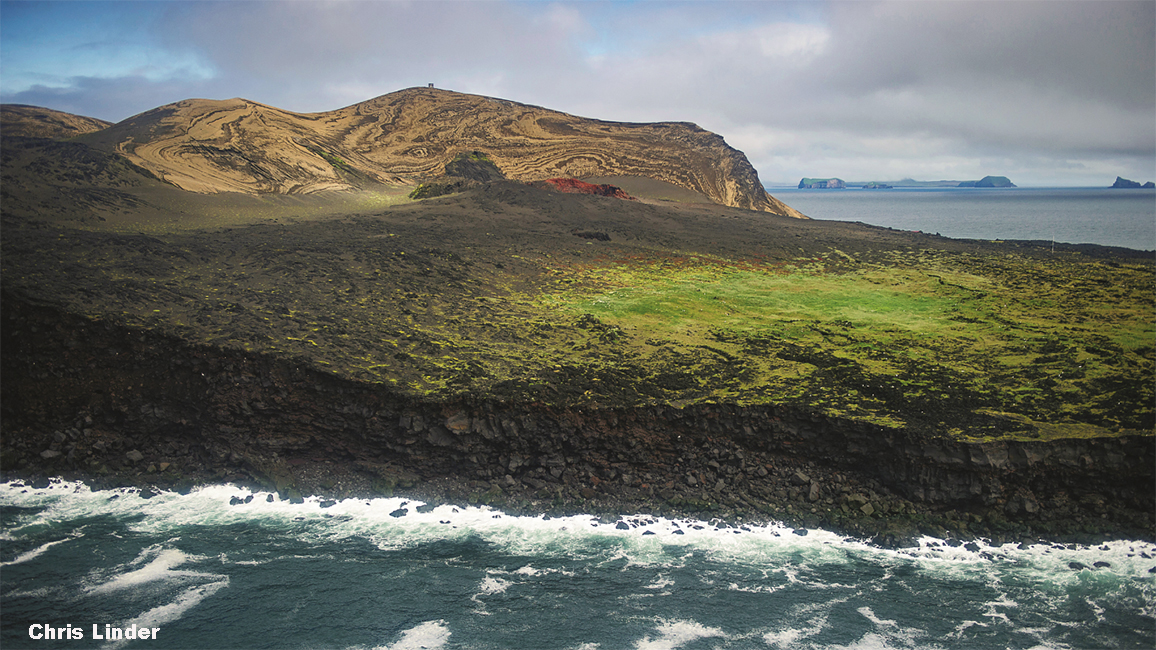
Birth of Surtsey Island
By Ellen Lambeth; photos by Chris LinderAn undersea volcano spews up so much lava and ash that it forms a new island. What happens next? Keep reading.
It all began in November of 1963. A volcano deep in the ocean off the southern coast of Iceland erupted. It began shooting up hot lava, steam, and ash. And it kept doing that for nearly four
years! The stuff kept piling up until it rose above the water’s surface. Finally, it started cooling off and hardening into the rocky island you see here.
It was named after Surtur, a mythical fire giant. “Surtur’s Island” translates into Surtsey (SURT-say) in the Icelandic language. So, in November 2023, we can say, “Happy birthday, Surtsey!” At 60 years of age, Surtsey is the youngest island on Earth.
See that green patch above the seaside cliffs? That means plants are growing there, right? But how did ANY life get started on a chunk of bare rock sticking up from the ocean?
Ah, THAT’s the very tale this island can tell! And who’s listening? Scientists! They’re the only people allowed to visit Surtsey, keeping track of what happens there over time. That way, they can describe the steps a brand-new island takes as it “grows up” naturally.
STEP 1
Plants were the first life forms to settle in. And the very first kind to do that was sea rocket. How did plants get there? Their seeds likely washed ashore with the waves.
STEP 2
An animal that might easily reach an island would be a seabird. The first one to show up on Surtsey was a black guillemot (GIL-uh-mot). Soon, more of these birds arrived and began to nest on
the island. From there, they could just fly out to the water to snap up their seafood meals.
TIME TICKS ON
Over the years, more plants would arrive on Surtsey, take root, and spread. Not all the seeds came by water, though. Some blew in on the wind. Others “hitchhiked” on (or in the stomachs of) birds. Meanwhile, the guillemots got a few more seabird neighbors. And then…
STEP 3
Different kinds of gulls, such as these lesser black-backed gulls, moved in and formed nesting groups called colonies. Along with the gulls came gull poop (often containing seeds from plants eaten elsewhere). The poop was a natural fertilizer. Mixed with dead plants, it made a new layer of rich soil for a greener “island garden”!

STEP 4
The gull colonies grew, too. Young gulls would grow up, then make nests and raise chicks of their own. At left, you can see how the black volcanic rock was becoming covered by green plants. Also notice how one mama gull had used the plants for making a soft nest to start laying her eggs in.
STEP 5
In some of the same ways plant seeds had moved in, insects (or their eggs) and other tiny creatures also arrived on the island. As their populations grew, they attracted insect-eating songbirds, such as the white wagtail. See its mouth stuffed with insects?
STEP 6
Now, at age 60, Surtsey continues to evolve (change over time). Of course, there’s plenty of sea life in the waters around the island. That includes seals that come ashore to rest and breed. But the seals and birds are the only Surtsey vertebrates (VUR-tuh-brutz, animals with backbones).

NEXT STEPS
What do you think the future of Surtsey might be? Will there be even more life moving in? Or will the sea eventually wash the island away? The scientists can make predictions, but only time will tell for sure. The good news is that the island has been protected since it was first formed. The little hut in the photo below is the only building there. Visiting scientists use it for their studies
Wouldn’t it be fun to find out how much Surtsey will have changed by the time YOU turn 60? Stay tuned!





















